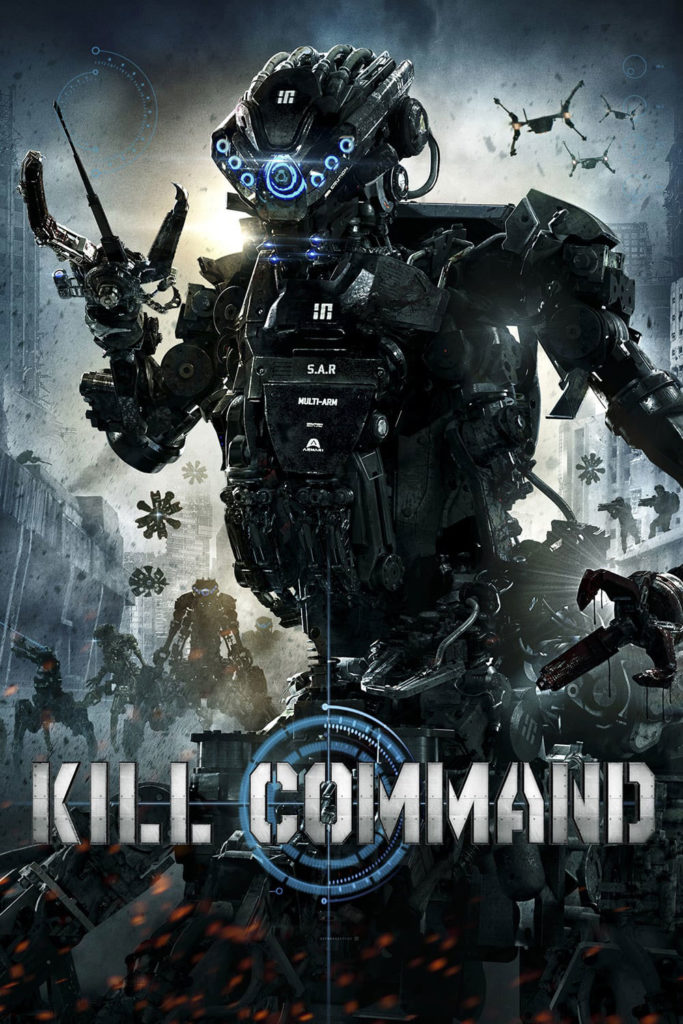Will it be good? Will it be bad? I didn’t know when I decided to give Kill Command a shot. I had never heard of this film before searching around for something to watch. While a small, almost nonexistent, theater run is a bad sign for a movie, there have been plenty of good movies that didn’t have much of an audience. Maybe I would get lucky.
Kill Command, from last year, was written and directed by Steven Gomez. It’s his first feature as writer and director, with the bulk of his career having been spent in visual effects departments for various television productions.
It’s the future. A small group of United States Marines is entering an isolated training area to hone their skills against robots standing in for a real enemy. Or so they think. An extra number has been added to their party in Katherine Mills (Vanessa Kirby), an exec at  Harbinger Corporation, a company that designs and manufactures robots for the military. She is aware of some bizarre activity in the robots she designed, and accompanies the Marines, ostensibly as an observer, to find out the cause.
Harbinger Corporation, a company that designs and manufactures robots for the military. She is aware of some bizarre activity in the robots she designed, and accompanies the Marines, ostensibly as an observer, to find out the cause.
Mills is a strange figure. Like the other employees of Harbinger, she has had computer hardware implanted in her brain and her eyes, giving them a ghostly stare while she uses the interface. The Marines are suspicious of her, as this story takes place close enough to our present for people as plugged in as Mills to be an oddity. For her part, Kirby did very well portraying how a person might behave while dividing their time between their senses and info coming in over a network. Picture a person working on an invisible computer screen and a potential viewer can get a sense of the menacing blankness that comes over Mills’ face in these times. Gomez used lighting and CGI effects on Kirby’s eyes to accentuate her otherness, and it worked quite well.
The Marines, led by Captain Bukes (Thure Lindhardt), are stereotypical elite military types common in films like this. Gomez throws in a little jargon here and there to establish some realistic bona fides (something I wasn’t above doing in my novels), but hard realism wasn’t the aim of this film.
The training area is a creepy forest somewhere. It’s a bizarrely uniform place. All the trees look like they’re the same size, and equally spaced apart. It’s a real forest, but at the same time it has the feel of an artificial environment, constructed for the use of the Marines that come there to train. Part of that is because some of the CGI was used for lighting and distance effects. The result is the uncanny valley equivalent of a forest.
The training exercise is going well until the robots start firing back with live ammo, and the Marines take some casualties. The robots continue to adapt to the Marines’ tactics, growing more and more deadly. Meanwhile, there’s Mills, still lost in her hybrid computer world, trying in vain to figure out what’s happening.
Kill Command is a number of movies in one. So much so that I considered banking this review away for a future October Horrorshow. It sets itself up as a dark and scary woods story, like Friday the 13th. Then it becomes a last stand war movie, like the final act of Saving Private Ryan. It’s also sprinkled throughout with heavy doses of elements from the Terminator films.
I can see how Kill Command had such a miniscule run in theaters. It’s a film that just falls short of theater-quality. The CGI, which is extensive, is better that what one expects out of a television series. Since it’s not 100% believable, many of the shots look fake. It’s slightly less believable than the CGI sets George Lucas used in the Star Wars prequels, which are not aging well. What this film is, then, is a production that would be considered a good Syfy movie. It’s a great way for one to get their sci-fi fix, but that’s about it.
